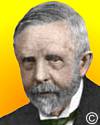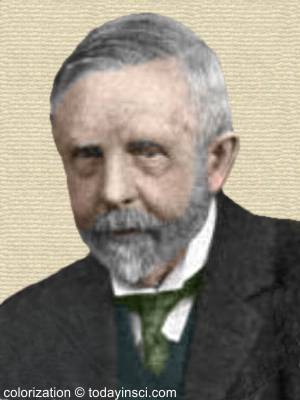 (source)
(source)
|
Sydney Evershed
(16 Sep 1857 - 18 Sep 1939)
English electrical engineer and inventor who co-founded the firm of Evershed and Vignoles, Ltd., manufacturers of electrical instruments. They conducted basic research in magnetic phenomena in the cores of transformers, permanent magnets and the physical structure of non-conductors.
|
Some Reminiscences Of Early Days.
by Sydney Evershed (1922)

Original b/w photo by G.C. Beresford
colorization © todayinsci (Terms of Use) (source)
[p.400] The older members of the Institution who are recalling their experiences of early days, are able for the most part to speak with the authority of men who themselves took an active part in the development of our great industry. I, too, remember those far-off days, but forty years ago my work lay almost entirely outside the electrical field and I cannot claim to have been much more than a spectator: a spectator, however, who knew a little about electricity and was keenly interested in what was going on.
Would that I had the power to recall the wonderful vision of a strange new world of electricity, that was so rapidly unfolding itself in the ’seventies and ’eighties. Anyone who lived in those times must be able to remember something of the wonder with which he first saw a dynamo at work, or heard a telephone speak. I am going to relate three incidents of that kind, each of which has left an indelible impression. I shall ignore chronological sequence and begin with what, in early days, was always called the electric light. It seemed appropriate to speak of it in the singular, because we seldom saw more than one arc lamp at a time; and what a great blaze of light it was to people who only knew the dingy gas lights in the street. But it was obviously impossible to have one’s house illuminated with arc lamps, and a strenuous search went on for some means by which that monstrous blaze of light might be divided into more manageable units. Everybody talked about it. The daily Press knew all about it, and the general expectation was that sooner or later the problem would be solved. Of course the great need was for smaller units of light, better fitted for general use than the arc lamp; and that is what we meant when we talked about dividing the electric light.
Well then, I remember one day reading an excited cablegram from America announcing that Mr. Edison, the great inventor, had succeeded in “dividing the electric light.” So far as I remember he did it by means of an incandescent platinum lamp. Then a little later I read an account of an interview given by Edison to some ecstatic American reporter, from which it appeared that after many months of fruitless thought [p.401] and experiment, during which the great inventor never went to bed (so I gathered), the problem went and solved itself, in the twinkling of an eye; by the accidental dropping of a screwdriver into the middle of an experiment!
Contemporary with this feverish method of research accompanied by propaganda, a quiet man here in England was working patiently at his invention of the carbon vacuum lamp. Never shall I forget my first sight of a Swan lamp. My home was a few miles from the town of Godalming, in Surrey, and Godalming in a strange burst of municipal enterprise, possibly induced by a dispute with the Gas Company, determined to light the streets of the town by electricity. Accordingly a dynamo was installed in Pullman’s leather mills, not far from the town, on the River Wey where water power was available. The electric lighting of Godalming began on the 15th December, 1881, and very soon afterwards I went on a visit of inspection. I found the leather mills lit up by what I was told were Swan lamps. I remember speaking with a workman, a leather worker there, who had the glorious illumination of a Swan lamp all to himself. But he was far from enthusiastic about it and was inclined to prefer a tallow candle.
I found many more Swan lamps lighting the smaller streets of the town; but the High-street was illuminated by three arc-lamps, flooding the little sleepy town and the sky overhead with a blaze of glory.
When I saw them the street-lighting cables were laid in all innocence in the gutter, with nothing but their innocence to protect them from the wheels of carts or the hoofs of cart horses. I remember kneeling on the pavement and holding a pocket compass against one of those cables, just to see the needle deflect. Imagine my bewilderment when I discovered that, for some reason unknown to me, electricity for street lighting did not deflect a magnetic needle. That was my first encounter with an alternating current.
But of all the things I saw that evening, nothing impressed me quite so much as those Swan lamps, the first incandescent electric lamps I had seen. I shall not enter into the old controversy of who was the first inventor. So far as patents go, I suppose Swan and Edison shared the invention. But for us, the members of this Institution, our own countryman will always have the first place, and in the long list of our Past Presidents [of the Institution of Electrical Engineers] there is no more honoured name than that of Joseph Wilson Swan, the father of domestic electric lighting.
I must not leave those cables at Godalming lying in the gutter. Of course they ought to have been put underground out of harm’s way. But in those days a street was regarded as the burial place for gas pipes and water mains, and anyone who proposed to lay an unhallowed electric cable in that consecrated ground came up against an immovable British institution, the Parish; and what goes with it, the Parochial Mind. Bury a cable in the street? It couldn’t be done. It would need an Act of Parliament.
And sure enough, in less than twelve months from the time I have been speaking of. Chamberlain’s notorious Electric Lighting Act was passed and the newly-born industry of public electric supply was snuffed out for the space of six years. Six years of arrested development. Now, a period of arrested development at the beginning of life, whether of a child or an industry, can never be made good. No Select Committees, no Royal Commissions, no Amending Acts of Parliament, can give us back those six years. From the year 1882 until the present time the business of public electric supply has been dominated by the Parochial Mind. One parish, one dynamo, has been the fundamental principle.
It is a relief to turn to another subject, the use of electricity as a means of instantaneous communication.
Telegraphy has had a long and curious history. It began with a wireless telegraph; an optical system. Yet, as we now know, the optical system was essentially an electric telegraph, working on a wave-length of about one forty-thousandth part of an inch, and using the human eye as the receiver. Then came the electric telegraph with wires to act as guides. And now we are using a wireless telegraph once more, but with a wave-length measured by hundreds of yards in place of a minute fraction of an inch.
An old optical telegraph between the Admiralty in London and the Dockyard at Portsmouth remained in use until somewhere about 1840, and both my father and my mother remembered quite well seeing it at work during their childhood. My own recollections of telegraphy begin in 1866, for I remember the laying of the Atlantic cable in that year: the first successful Atlantic cable. At breakfast time each morning my father used to read out of the newspaper to us children the daily message from the ship that was laying that cable. I was too young to realize all that it meant. I don’t remember giving a thought to America. What impressed itself on the mind of a child was the fact that those men out there in the middle of the ocean were sending a message back to England through the Atlantic cable. There was a spaciousness about it, and a spirit of adventure, that appealed to the imagination. It was a good breakfast for a small boy.
Since that time the scattered countries all over the world have been linked together by a network of cables, to the incalculable benefit of mankind; a great work carried out by private enterprise, unrestricted by narrow-minded legislation. It is good to remember that it has been done almost entirely by our own countrymen. Theirs was a scientific knowledge; theirs the technical skill. And above all, theirs the magnificent courage. For it needed courage to lay enormously expensive cables on the bottom of the sea, with all its unknown dangers and obstructions. One obstruction they escaped: there are no Government Departments on the bottom of the sea.
So far all electrical communication had been by code; spelling out the message letter by letter. But presently we were to learn that speech itself could be transmitted and reproduced. It was in the year 1876, the year of the Centennial Exhibition at Phildelphia, that I first heard of Graham Bell’s telephone. I had already heard of elaborate machines which were to speak. Somewhere I had read of one which was to contain hundreds of delicately tuned reeds, covering [p.402] the whole gamut of the human voice. And goodness knows what it was to contain in the way of other complications. Immense complexity: that was the dominant idea in my mind about machines for reproducing speech, when one morning in 1876 I read in the newspaper an account of some of the exhibits at the Centennial Exhibition. About half-way down the column, without a word of warning, I found myself reading a sentence that went something like this: “I have listened to Hamlet’s soliloquy ‘To be, or not to be,’ spoken by Dr. Graham Bell’s telephone.” Barely a couple of lines, so far as I remember. I read that sentence again and again, trying to extract something more from it; one half of my mind full of wonder, the other half full of doubt.
But it turned out to be true and, little by little, I heard more about the telephone. A year later I saw a drawing of one, and a new wonder came to light. Where were all those imagined complications? To my astonishment there was an entire lack of complication. On the contrary the thing was incredibly simple. So simple that I at once set to work and made two Bell telephones, one to act as transmitter and the other as receiver; the two being identical, of course. My telephone consisted of a small bar magnet with some silk-covered wire wound in a coil round one pole, and a disc of thin sheet-iron which I cut out with a pair of scissors. I fixed these things inside a wooden baking-powder box which my mother gave me, and with my knife I cut a hole in the lid to let the sound into the transmitter and out of the receiver— always supposing that by some amazing miracle there should be any sound whatever to come out. I was already the proud proprietor of a telegraph line, and to this I connected my telephones, one at each end.
All being prepared I engaged the services of a lady as telephone operator. For simplicity I will refer to her as Jane. At that time Jane was about eleven years of age; nowadays we should consider that rather young for a girl telephone operator. Having stationed Jane at one end of the line with the baking-powder box at her ear, and strict injunctions as to procedure, | I went to the other end and took up the other baking-powder box in order to speak to it. Then I tried to think of something to say. Next, I realized how silly it would be to speak to an inanimate object; actually to talk to a baking-powder box! However, I reflected that there was nobody there to see me making a fool of myself and so I made my first speech to the telephone. “Jane, can you hear what I say?” Then feeling even more foolish but a little excited, I put the baking-powder box to my ear. Instantly I became aware of the miraculous truth, for I heard a small but perfectly clear voice coming from inside the baking-powder box and saying: “Yes, I can hear you quite plainly.”
I do not know how to describe what rushed into my mind when I heard that small voice. I hear the very sound of those words to-day as I did then and the wonder of it is as vividly present in my mind at this moment as it was 45 years ago.
Well, since that day a good deal of the glamour has been rubbed off the telephone. If anyone were to go outside this building and ask the first man he met what he thinks about it, he would probably tell you that the telephone is an infernal nuisance, mismanaged by the Postmaster-General. But the gibe is not altogether justified. It would be nearer the truth to say that our telephone service, with all its shortcomings, including the Postmaster-General, is a faithful reflection of our national temperament. At all events that is a consoling thought when we get a wrong number.
But I will not end on a controversial note. At the time I have been trying to recall, the elaborate system of telephonic communication which has come into use all over the world could only have been vaguely foreseen. The telephone at that time was just the latest wonder of a wonder-working age; a scientific marvel by which the spoken word could be instantaneously reproduced at a distance.
And what is it that performs this miracle of speech? Look at it again. This small magnet. This tiny coil of wire. This little disc of iron. These three things, and a container of some sort to hold them together—a baking-powder box will do. So arranged, this little disc of iron, a mere scrap of sheet-iron, has the power of speech. To-day it is speaking to the telephone user all over the world about his everyday affairs. And sometimes not without a touch of romance, as when it speaks to the lonely pilot of some aeroplane up above the clouds. Was ever so profound an influence on our daily life brought about by such simple means? I can think of nothing, no invention that approaches it. In supreme simplicity directed to a great end Graham Bell’s invention stands absolutely alone.
- Science Quotes by Sydney Evershed.
- 16 Sep - short biography, births, deaths and events on date of Evershed's birth.




